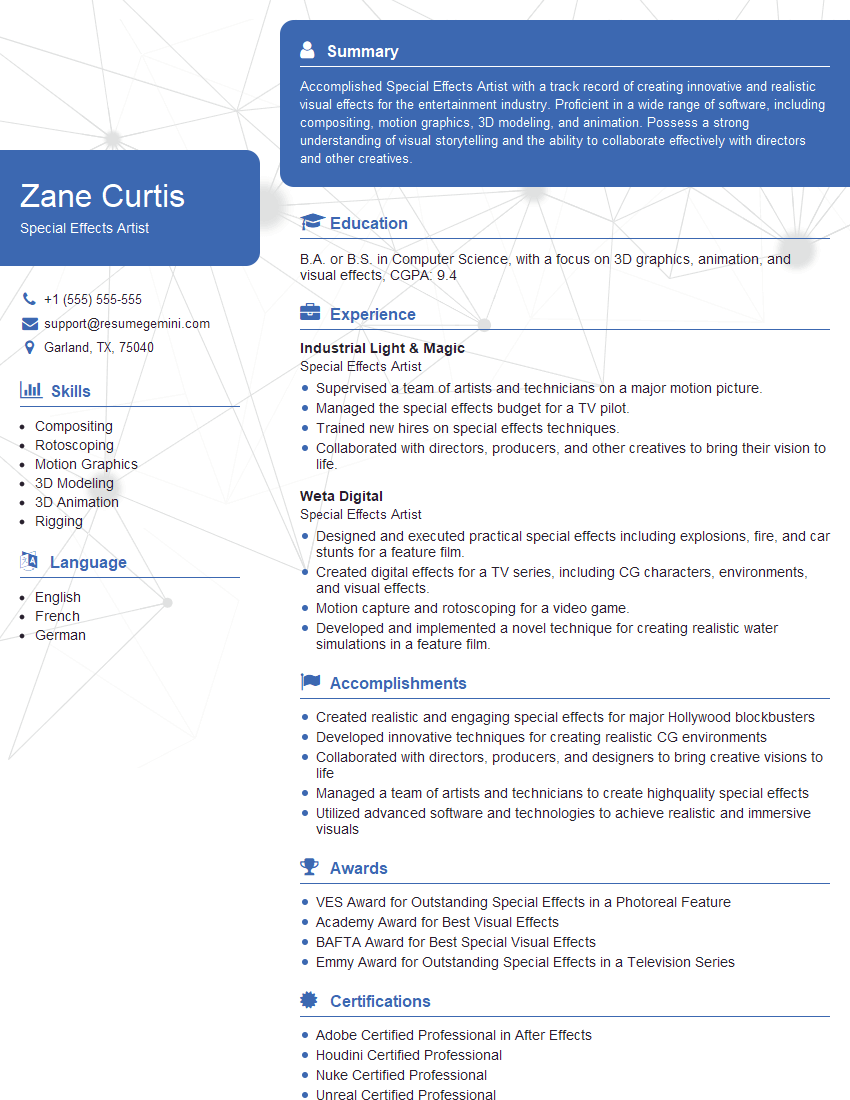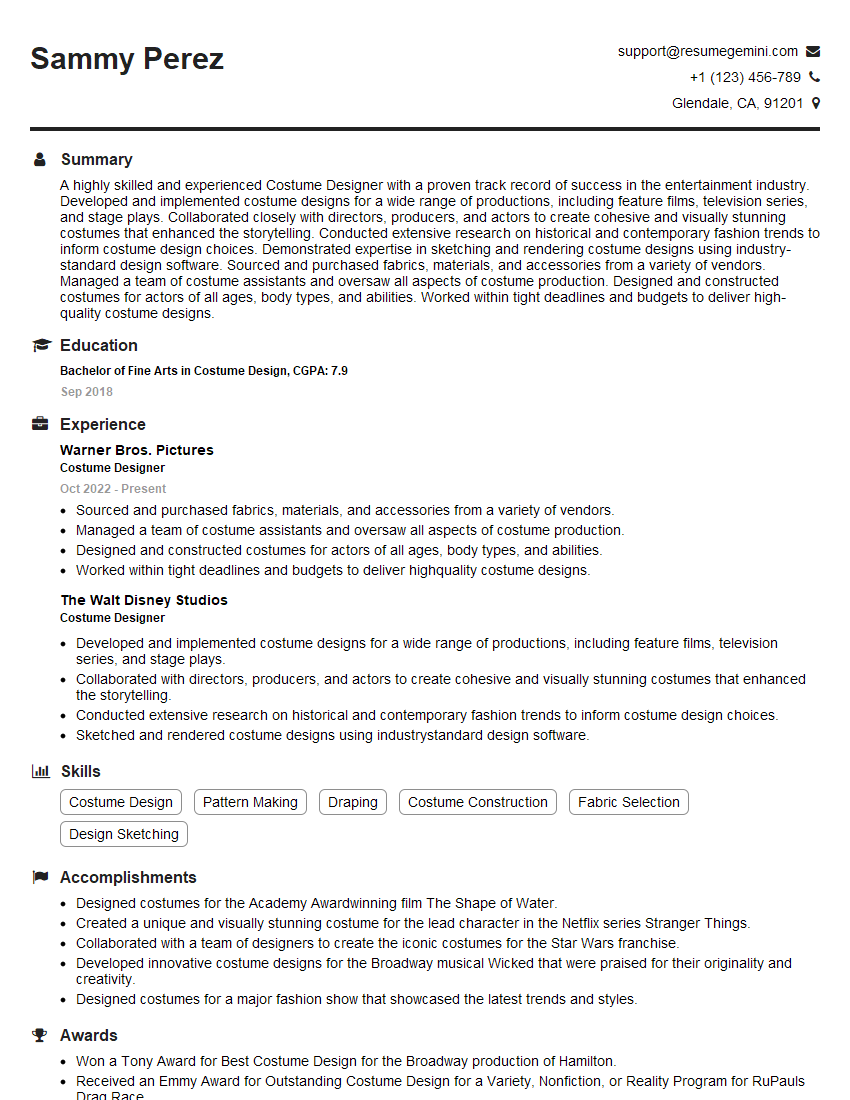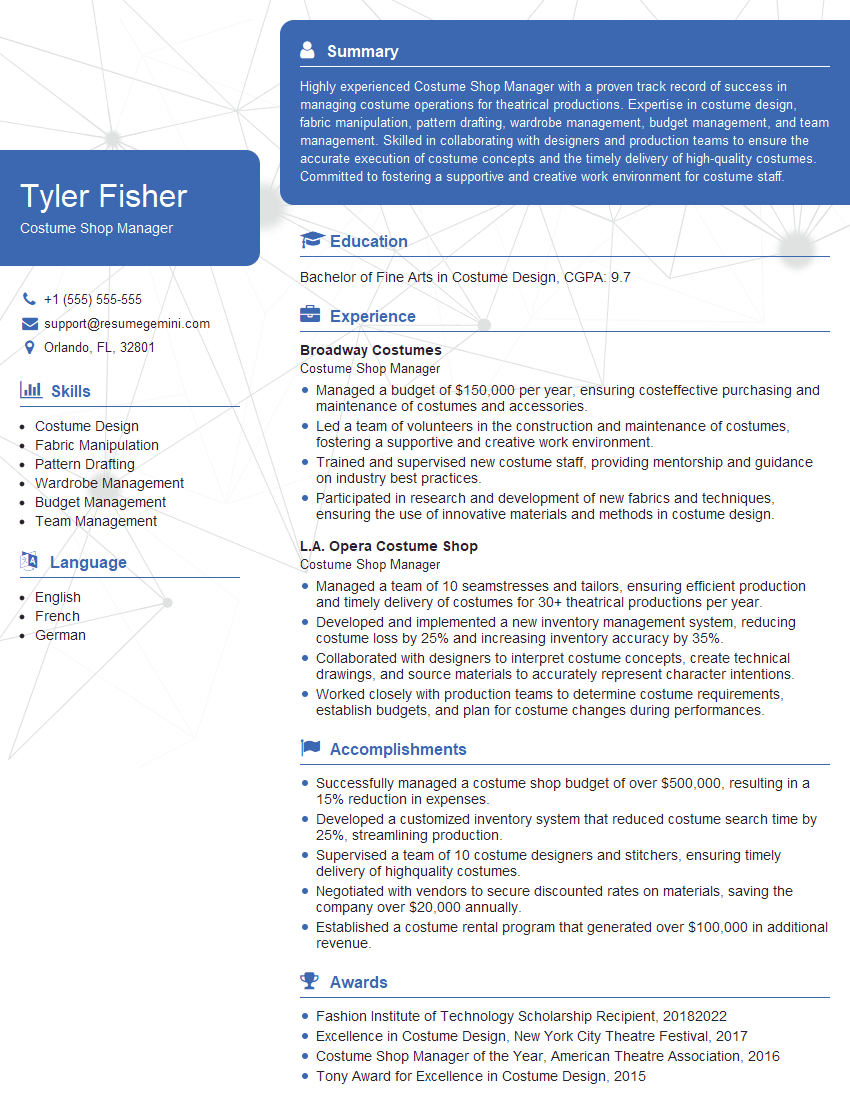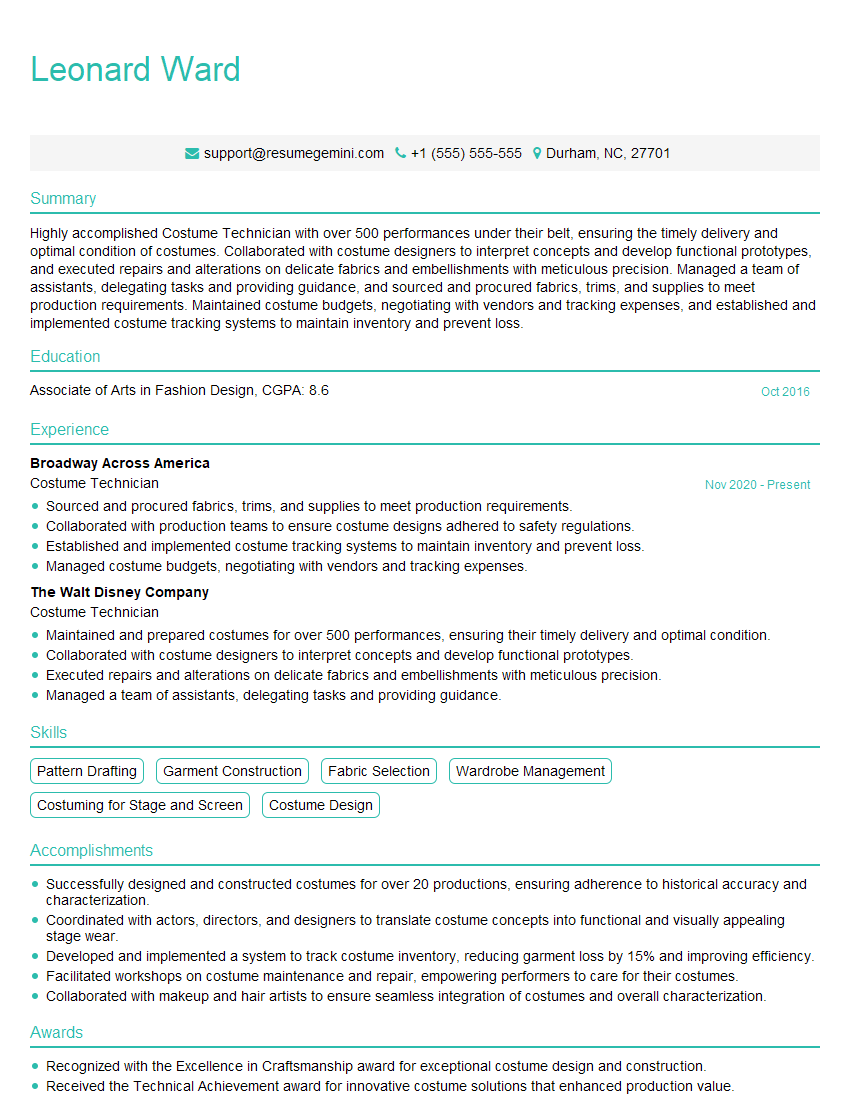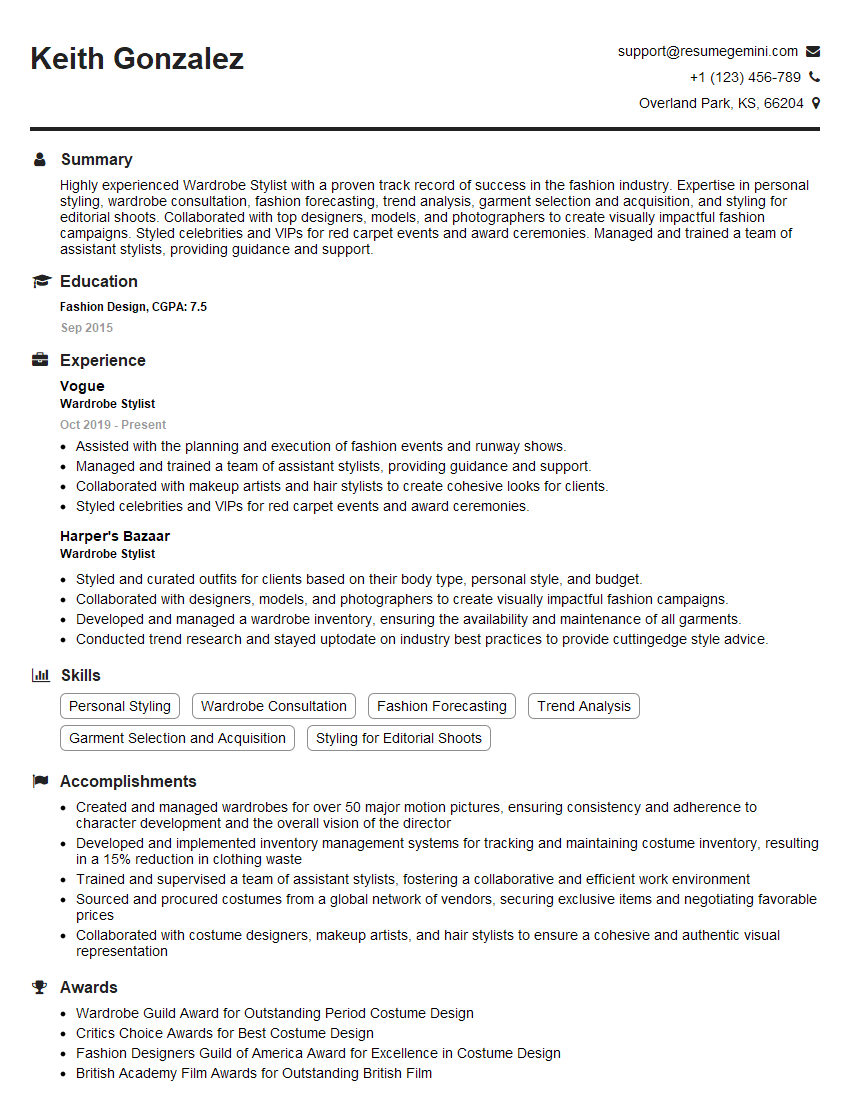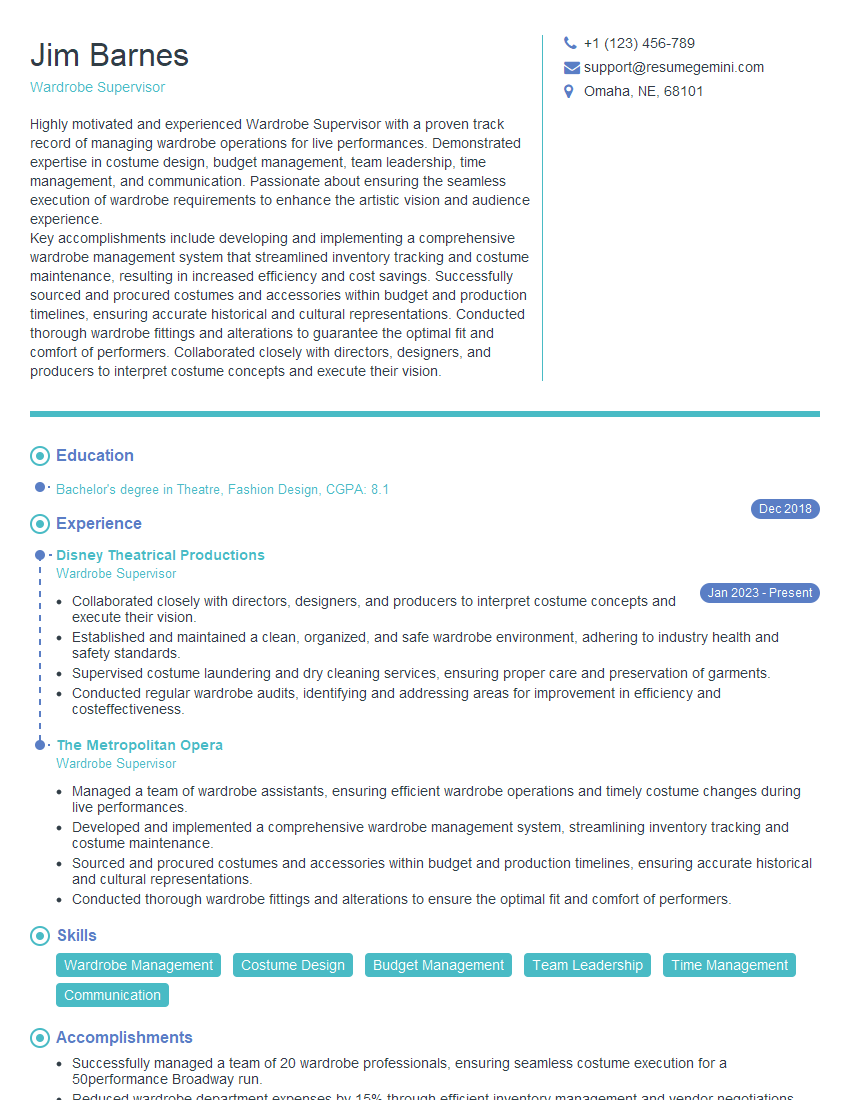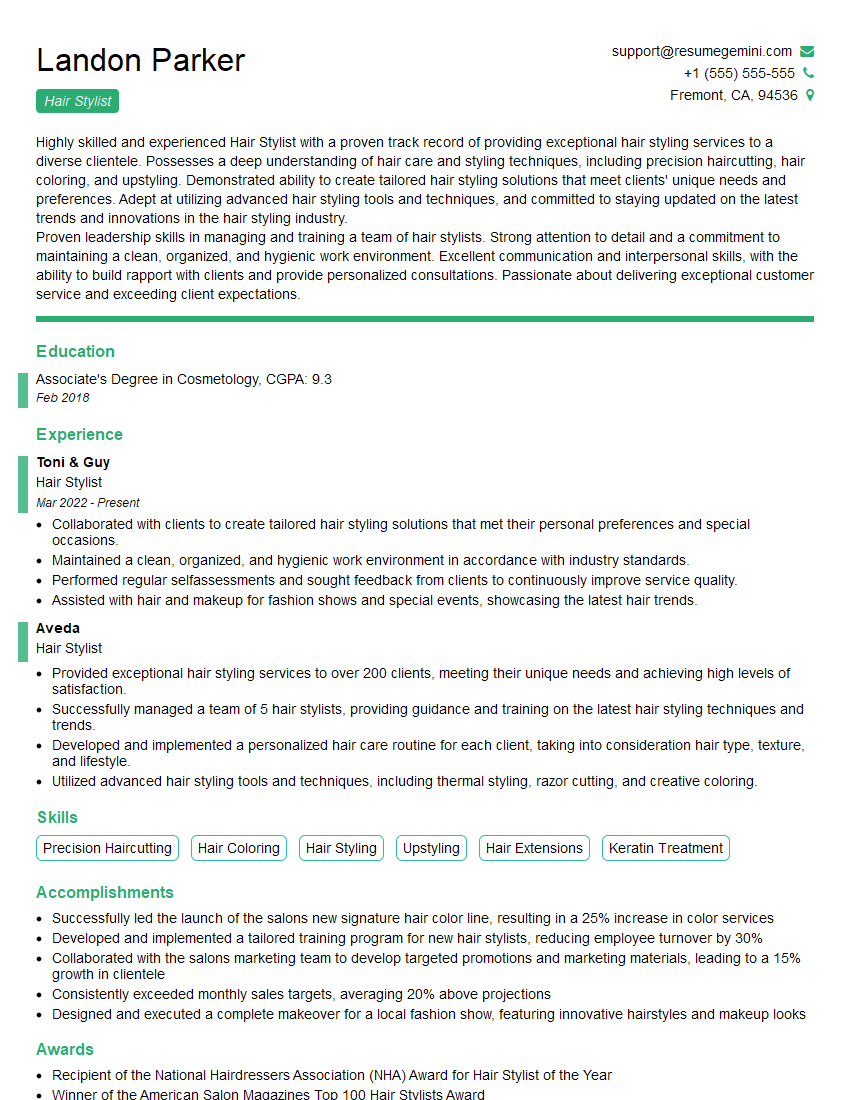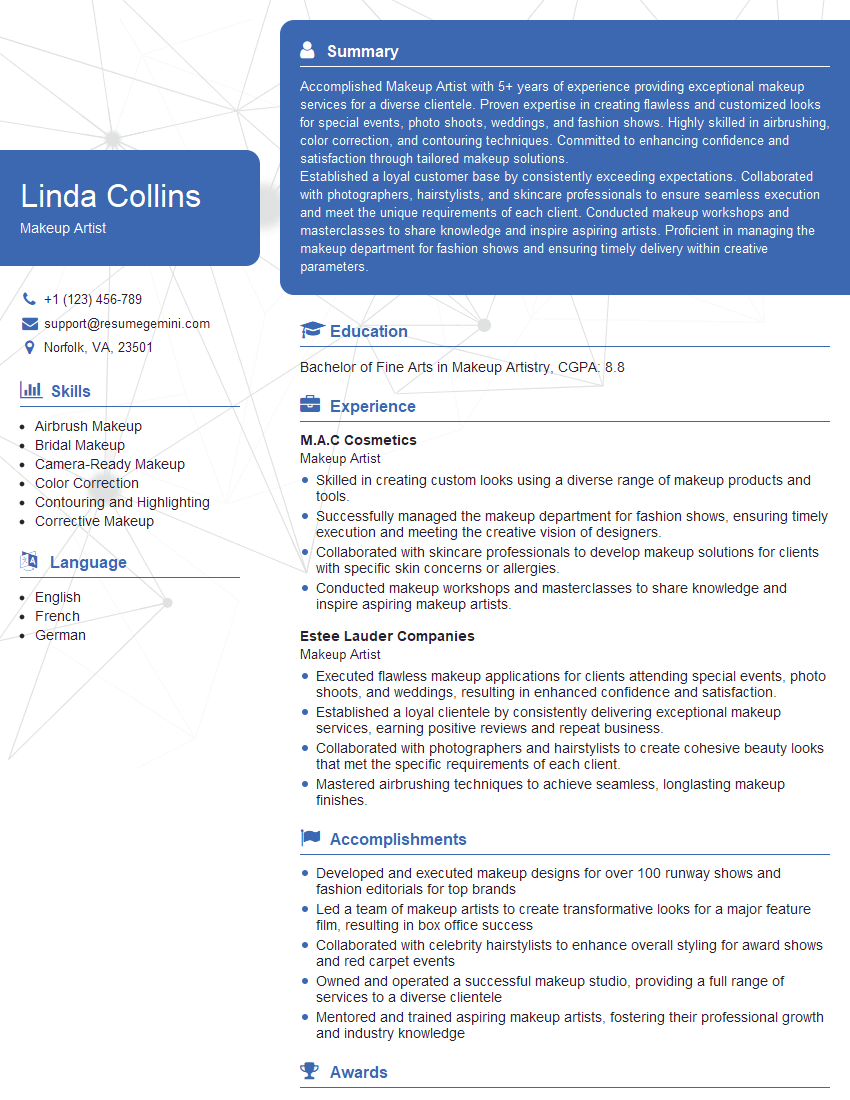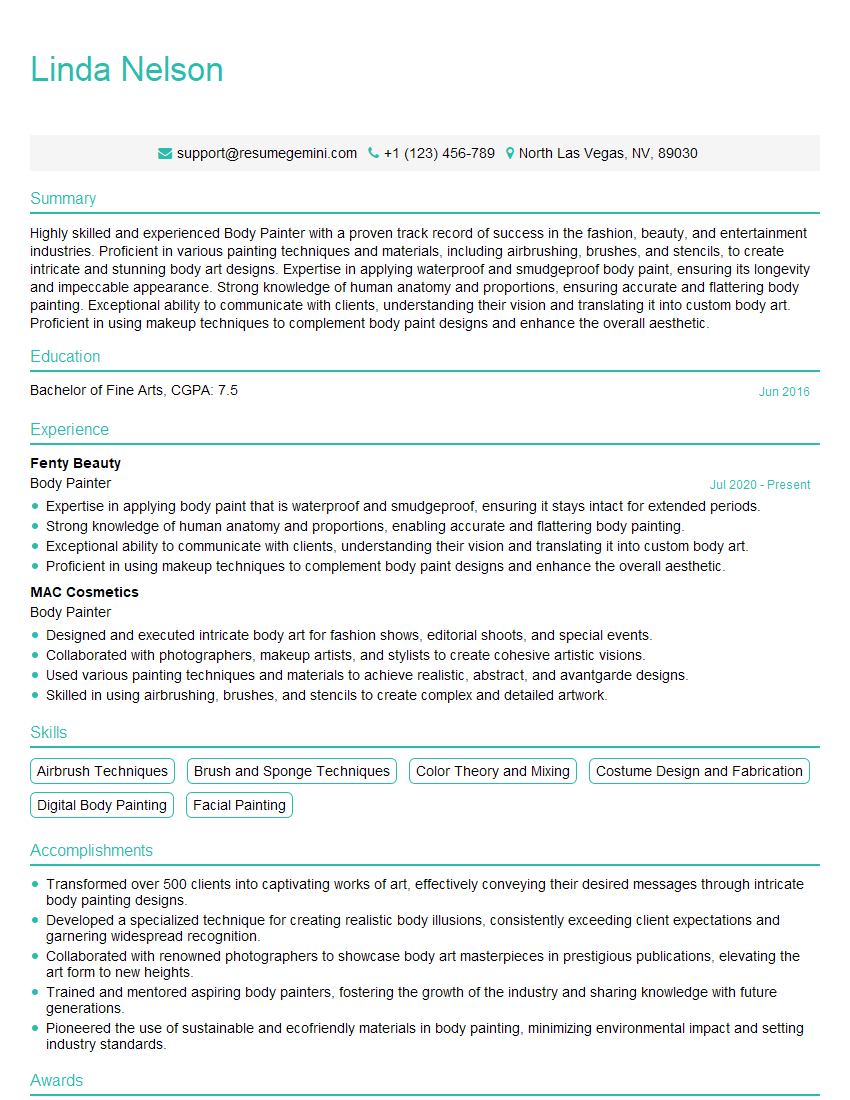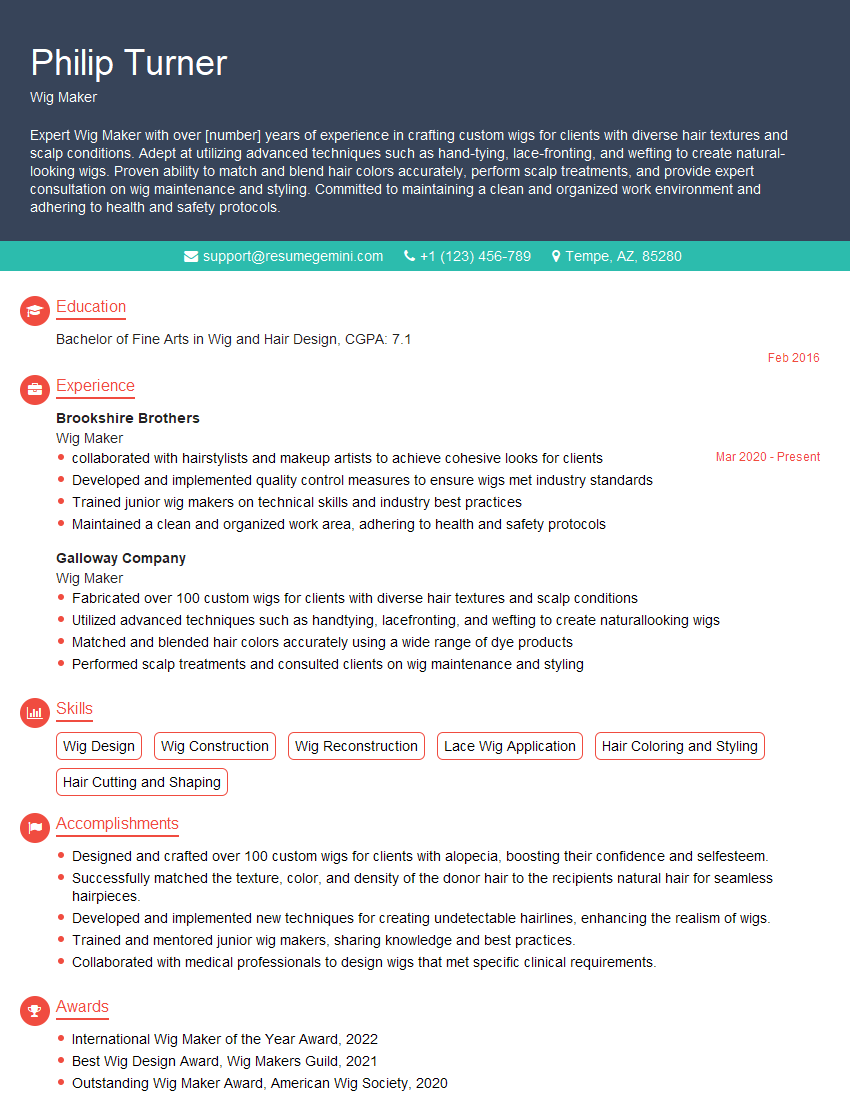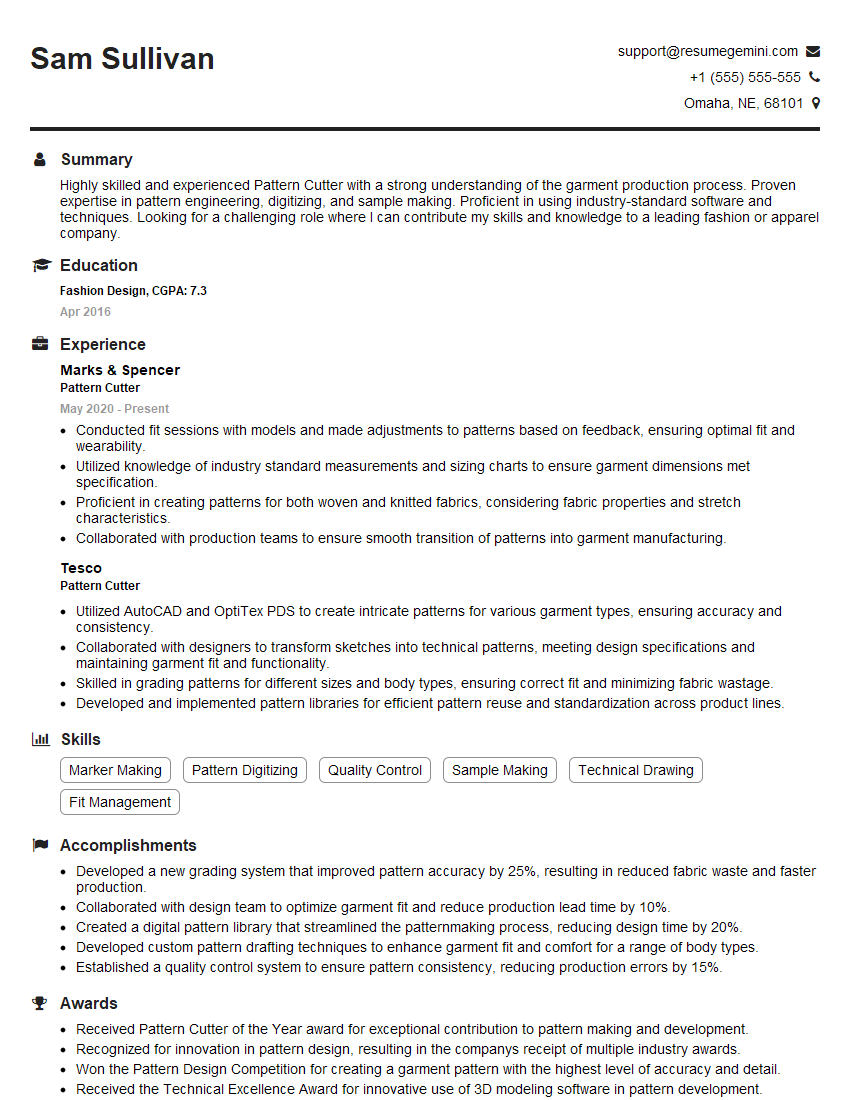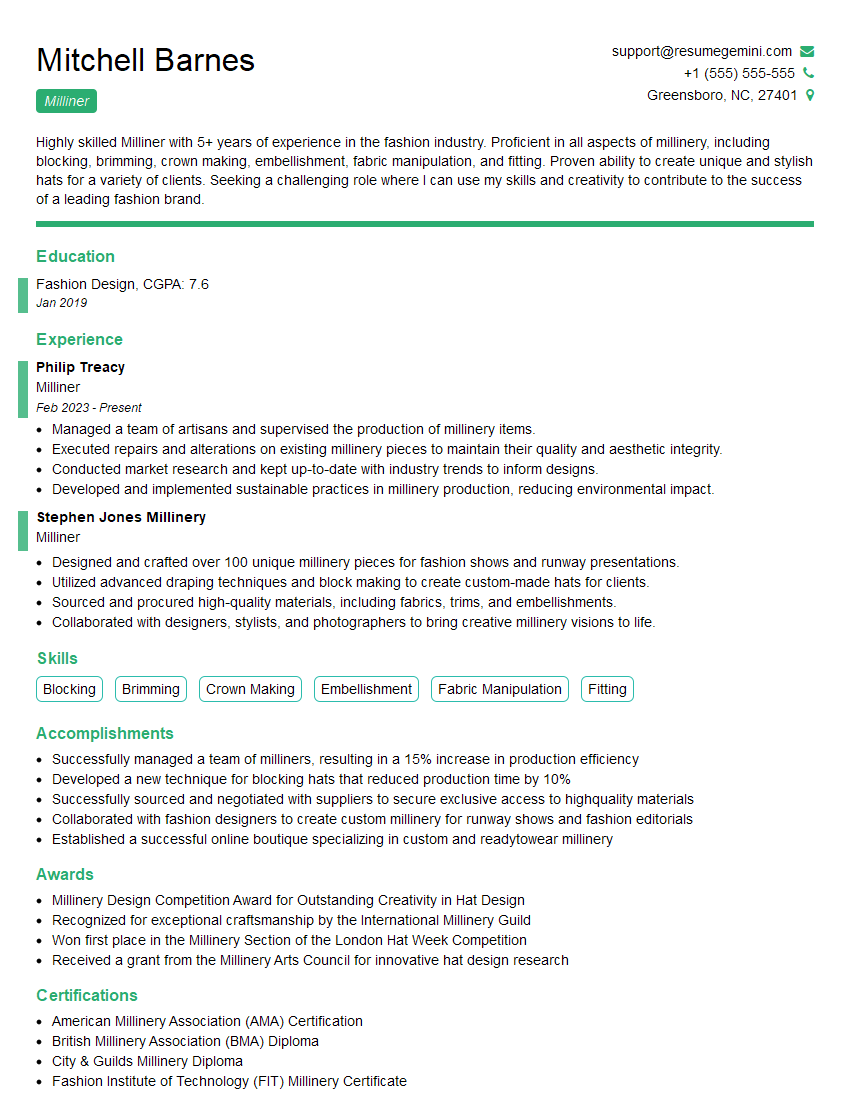Preparation is the key to success in any interview. In this post, we’ll explore crucial Costuming and Makeup interview questions and equip you with strategies to craft impactful answers. Whether you’re a beginner or a pro, these tips will elevate your preparation.
Questions Asked in Costuming and Makeup Interview
Q 1. Describe your experience with different fabric types and their suitability for various costumes.
Understanding fabric properties is crucial for successful costuming. Different fabrics drape, behave, and age differently, significantly impacting a costume’s final look and functionality.
- Silk: Luxurious and delicate, ideal for flowing gowns or regal garments. However, it requires careful handling and dry cleaning. I once used silk charmeuse for a Victorian-era gown, its sheen and drape perfectly capturing the era’s elegance.
- Linen: Durable and breathable, perfect for historical pieces or robust fantasy costumes. Linen wrinkles easily, adding to its authentic texture in period pieces.
- Wool: Warm and sturdy, suitable for coats, jackets, and medieval garments. Its texture adds depth and realism, especially when depicting heavier clothing.
- Cotton: Versatile and affordable, cotton can be used in many contexts, from everyday wear to simple costumes. Its easy maintenance makes it a practical choice for less demanding projects.
- Synthetics (Polyester, Nylon): Affordable and easy to maintain, synthetics are often used in modern or fantasy costumes where durability and low cost are prioritized. However, their lack of breathability and sometimes unnatural sheen can be a limitation.
Choosing the right fabric depends on the character, period, and budget. For example, a delicate fairy costume might call for sheer chiffon or silk, while a rugged warrior costume might need heavy canvas or leather.
Q 2. Explain your process for creating a character’s look through makeup.
Creating a character’s look through makeup is a multi-step process that starts with understanding the character’s personality, history, and environment.
- Character Analysis: I begin by thoroughly analyzing the character’s script, background, and visual references. This helps determine the desired mood and overall aesthetic.
- Skin Preparation: Clean, moisturized skin is essential for a flawless base. I use primers to create a smooth surface and ensure makeup longevity.
- Base Makeup: I select foundation, concealer, and powder that match the character’s skin tone, paying close attention to undertones to avoid a mask-like effect. This often involves color correction to address imperfections or create specific effects like bruises or pallor.
- Feature Definition: I sculpt and shape the face using contouring and highlighting techniques. Eyebrows are carefully defined, and eyes are enhanced to match the character’s emotions and age.
- Special Effects (if needed): For more complex characters, I might utilize prosthetics, special effects makeup (like cuts, burns, or aging techniques), or airbrushing for a seamless finish.
- Finishing Touches: Setting spray ensures that the makeup lasts and a final touch-up addresses any imperfections or smudging.
For instance, for a villainous character, I might use darker contouring and a more dramatic eye look, while a sweet, innocent character might require lighter makeup and a natural flush.
Q 3. How do you manage time effectively when working on multiple costume projects simultaneously?
Managing multiple costume projects effectively requires meticulous planning and organization.
- Prioritization: I prioritize projects based on deadlines and complexity. Urgent projects with tight deadlines receive immediate attention.
- Detailed Scheduling: I create a detailed schedule that breaks down each project into manageable tasks. This allows me to allocate specific time slots for different activities like fabric sourcing, pattern making, construction, and finishing.
- Task Delegation (if possible): For larger projects, I delegate certain tasks to assistants or other team members, if available. This allows for efficient workflow and distribution of workload.
- Time Blocking: I utilize time blocking techniques to allocate specific time blocks for particular tasks. This prevents distractions and improves focus.
- Regular Check-ins: I regularly assess progress and adjust my schedule as needed to account for unexpected delays or challenges.
For example, if I have three projects, one a historical gown, one a fantasy costume, and one a simpler modern outfit, I might dedicate mornings to detailed tasks on the historical gown, afternoons to construction on the fantasy costume, and evenings to finishing the modern outfit.
Q 4. What are your preferred techniques for applying prosthetic makeup?
Applying prosthetic makeup requires precision and attention to detail. My preferred techniques focus on achieving a seamless, natural look.
- Preparation: Thorough skin cleansing and prepping are crucial. I use adhesive remover to remove any previous makeup and then apply a skin prep solution to create a clean surface for adhesion.
- Adhesive Application: I use a high-quality prosthetic adhesive, applying it carefully to both the prosthetic and the skin. This ensures secure attachment and prevents unwanted lifting or movement.
- Prosthetic Placement: I carefully position the prosthetic, ensuring proper alignment and blending. I often use blending agents to ensure a smooth transition.
- Seamless Blending: Once the prosthetic is in place, I meticulously blend the edges using makeup and other blending techniques. This minimizes any visible seams or lines.
- Finishing Touches: I use makeup, including foundation, concealer, powder, and other color correction products, to further enhance the prosthetic’s realism and match it with the surrounding skin.
I often use a combination of liquid latex and silicone prosthetics, depending on the desired effect and the character’s needs. For instance, I might use a silicone prosthetic for a subtle scar and liquid latex for a more dramatic wound.
Q 5. Describe your experience with period-specific costuming.
Period-specific costuming requires extensive research and attention to historical accuracy.
My experience includes recreating costumes from various eras, including Victorian, Medieval, Renaissance, and Ancient Roman periods. This involves studying historical garments, analyzing paintings, and researching fashion trends of the specific time period. I consult with historians, read scholarly articles, and examine original garments (when available) to ensure authenticity. For instance, when recreating a Victorian gown, I carefully consider the silhouette, fabrics, embellishments, and construction techniques typical of the era.
One challenging project involved recreating a 15th-century gown for a museum exhibit. It required extensive research into textile techniques and construction methods of the time to replicate the garment accurately. The accuracy was so high, it was displayed in the museum’s historical costume collection.
Q 6. How do you adapt your makeup techniques for different skin tones and types?
Adapting makeup techniques to different skin tones and types is essential for creating inclusive and realistic looks.
I select foundations, concealers, and powders that match the individual’s skin tone and undertones precisely. I avoid using a ‘one-size-fits-all’ approach, recognizing that diverse skin tones require different shades and formulations. For example, deeper skin tones might need richer undertones or specific formulations that account for their natural oils.
I also tailor my techniques to specific skin types. Oily skin requires different products and techniques than dry skin. For example, I might use a matte foundation for oily skin and a hydrating base for dry skin. Understanding skin conditions like acne or rosacea is also crucial. I adjust my techniques to accommodate these and to avoid potential irritation.
Q 7. Explain your understanding of color theory in relation to costume and makeup design.
Color theory is fundamental to both costume and makeup design. It governs how colors interact, affect mood, and create visual harmony or contrast.
- Complementary Colors: Colors opposite each other on the color wheel (e.g., red and green, blue and orange) create high contrast and visual excitement. This can be used strategically in costumes to draw attention to certain areas or characters.
- Analogous Colors: Colors adjacent to each other on the color wheel (e.g., blue, blue-green, green) create a harmonious and soothing effect. This is often used to create a cohesive and visually pleasing look in costumes.
- Warm vs. Cool Colors: Warm colors (reds, oranges, yellows) evoke feelings of energy and warmth, while cool colors (blues, greens, purples) create a sense of calm and serenity. This impacts the overall mood and character portrayal in both costume and makeup.
- Color Temperature and Skin Tones: Understanding the temperature of colors is crucial when applying makeup. Selecting foundations and color correctors requires attention to the warmth or coolness of the skin tone.
For example, a costume design might use analogous colors (various shades of blue and green) to create a serene underwater scene, while the character’s makeup could incorporate complementary colors (e.g., a blue eyeshadow contrasted with an orange blush) to highlight the face.
Q 8. How do you handle challenges such as unexpected alterations or damaged costumes on set?
On set, unexpected alterations or costume damage are par for the course. My approach is proactive and methodical. First, I assess the damage – is it repairable on site, or does it require a complete replacement? For minor issues like a small tear or loose seam, I have a well-stocked kit with needles, thread, fabric glue, and various patches. I can usually make quick repairs without disrupting filming. For more significant damage, I immediately contact the wardrobe department to discuss options. This might involve using a similar garment as a replacement or, if time permits, making a quick replica using readily available materials. The key is quick thinking, resourcefulness, and excellent communication.
For example, on a recent period drama, an actor ripped the sleeve of their elaborate velvet jacket just before a crucial scene. Instead of panicking, I swiftly used a similar colored velvet scrap from the costume’s remaining fabric and carefully patched the tear, using invisible stitching. The repair was undetectable on camera, and filming continued without interruption.
Q 9. What software programs are you proficient in for costume design or makeup artistry?
Proficiency in design and artistic software is essential for my work. I’m highly skilled in Adobe Photoshop for image manipulation, creating mood boards and detailed costume sketches, and enhancing photos for portfolios. I also use Adobe Illustrator for creating precise vector illustrations of costume patterns and designs. For 3D modeling, which is increasingly important for visualizing complex costumes and effects, I utilize Blender. In makeup artistry, I frequently use Procreate for digital painting and sketching makeup looks, useful for creating concept art and presenting designs to clients.
Q 10. Describe your experience with creating different wig styles and applications.
My wig experience encompasses a wide range of styles and applications, from period pieces requiring intricate updos to modern styles needing seamless integration with the actor’s hair. I’m proficient in various wig-making techniques, including cutting, styling, coloring, and customizing wigs to perfectly match the character’s personality and the production’s aesthetic. I’m skilled in creating both natural and exaggerated styles, employing methods like teasing, braiding, and using heat styling tools to achieve the desired volume, texture, and shape. Furthermore, I’m adept at secure wig application techniques, ensuring comfort and durability throughout a shoot. I understand the importance of proper cap fitting and the use of adhesives or tapes for long-lasting wear, paying close attention to minimizing scalp irritation or discomfort.
For example, I once created a 17th-century-inspired wig for a historical drama. This involved extensive research into the hairstyles of the period, sourcing appropriate hair materials, hand-weaving sections of the wig, and then carefully styling it to accurately reflect the period’s conventions.
Q 11. How do you maintain hygiene and safety standards in your makeup application process?
Maintaining hygiene and safety is paramount in my makeup application process. I strictly adhere to a strict protocol. All my brushes and tools are thoroughly cleaned and disinfected between each application, using appropriate antibacterial solutions. I use disposable sponges and applicators whenever possible, and I always keep my workstation clean and organized. I follow guidelines set by the relevant health and safety regulations, including those pertaining to the handling of cosmetics and the prevention of cross-contamination. I always ensure that products are within their expiry dates and are appropriate for the individual’s skin type to prevent any allergic reactions. Client consultation is key; I thoroughly discuss any allergies or sensitivities before commencing the application. This ensures the safety and well-being of the actors or models I work with.
Q 12. Explain your understanding of different makeup techniques for film, theatre and fashion.
Makeup techniques vary significantly across film, theatre, and fashion. Film makeup needs to be subtle yet impactful, able to hold up under intense lighting and close-ups. It often necessitates techniques like airbrushing for a flawless finish and careful contouring to sculpt the face. Theatre makeup, conversely, requires a bolder approach; it needs to be visible from a distance and should withstand stage lighting, often involving strong color contrasts and highly defined features. Fashion makeup often prioritizes trends and artistic expression, employing innovative techniques and products to create dramatic, striking, and frequently experimental looks. I’m comfortable working across all these mediums and adjust my techniques accordingly.
Q 13. How do you work collaboratively with other departments such as wardrobe, hair and set design?
Collaboration is key in any production. I constantly liaise with wardrobe, hair, and set design to ensure a cohesive look. With wardrobe, we discuss the costume’s color palette, fabric, and style to ensure that the makeup complements the overall design. With the hair department, we coordinate hairstyles and makeup to create a unified look, ensuring both elements are harmonious. With set design, I consider the lighting and overall environment to design makeup that is not only aesthetically pleasing but also visually appropriate for the setting. Early communication and joint planning sessions are essential for seamlessly integrating all these elements.
Q 14. Describe your experience with creating special effects makeup for wounds or injuries.
Creating realistic special effects makeup for wounds or injuries requires meticulous attention to detail and a thorough understanding of anatomy and wound healing. I’m skilled in applying various techniques like prosthetic application, sculpting with silicone, creating realistic-looking blood and other fluids, and using airbrushing for detailed effects. Safety is paramount; I always use appropriate materials and techniques to avoid skin irritation or infections. My process involves creating a detailed plan that considers the nature of the injury, the desired level of realism, and the practical requirements of the production. I have extensive experience in creating everything from minor cuts and bruises to deep lacerations and burns, using a variety of techniques and materials to achieve the desired effect.
For instance, I once created a prosthetic for a character with a severe facial wound. This involved creating a mold of a clean, healthy face, crafting the prosthetic from silicone, painting it to accurately mimic the color and texture of skin, and applying it seamlessly to the actor’s face. The result was a convincing and visually striking injury that effectively enhanced the scene.
Q 15. How do you manage the budget and resources allocated for costumes or makeup?
Budget management in costuming and makeup is crucial for successful projects. My approach begins with a thorough breakdown of the project’s requirements. This involves creating a detailed list of all necessary materials, including fabrics, paints, tools, and any potential special effects. I then research supplier options, comparing prices and quality to find the most cost-effective solutions without compromising on the project’s aesthetic standards. For instance, for a period drama, sourcing vintage fabrics from reputable dealers might be more expensive initially, but ultimately saves on the cost of labor for recreating intricate patterns. I also build in contingency funds to account for unforeseen expenses, such as fabric damage or unexpected material shortages. Finally, I regularly monitor spending against the allocated budget, making adjustments as needed to ensure we stay within the financial parameters.
For larger projects, I might utilize spreadsheet software to track every expense, providing detailed reports to the production team. This ensures transparency and allows for informed decision-making throughout the process.
Career Expert Tips:
- Ace those interviews! Prepare effectively by reviewing the Top 50 Most Common Interview Questions on ResumeGemini.
- Navigate your job search with confidence! Explore a wide range of Career Tips on ResumeGemini. Learn about common challenges and recommendations to overcome them.
- Craft the perfect resume! Master the Art of Resume Writing with ResumeGemini’s guide. Showcase your unique qualifications and achievements effectively.
- Don’t miss out on holiday savings! Build your dream resume with ResumeGemini’s ATS optimized templates.
Q 16. What is your approach to sourcing materials and fabrics for costume construction?
Sourcing materials is a critical aspect of my work, impacting both budget and the final product’s quality. My process starts with understanding the project’s specific needs: the period, the style, the character’s personality. For a historical costume, I might research authentic textiles from the era, perhaps visiting museums or consulting historical textile archives. For a fantasy project, I’m open to exploring more unconventional materials like repurposed fabrics, faux leather, and even found objects to create unique and interesting textures. I always consider the material’s durability, ease of maintenance, and suitability for the actors’ comfort.
I collaborate extensively with fabric suppliers and costume houses, establishing strong working relationships to ensure reliable access to a diverse range of materials. Online marketplaces can also offer unique finds, but in-person inspections are crucial to assess quality and texture before committing to a purchase. For example, I recently sourced hand-woven silk from a small artisan workshop for a period piece—the cost was higher, but the unique quality and sustainable sourcing justified the expense.
Q 17. How familiar are you with different draping and pattern-making techniques?
I’m highly proficient in various draping and pattern-making techniques, which are fundamental to creating bespoke costumes. Draping involves directly shaping fabric on a dress form to create a three-dimensional garment. This is ideal for creating flowing, sculptural pieces or for achieving a unique fit on an actor. Pattern-making, on the other hand, involves creating flat templates that are then cut and sewn together. This is better suited for garments requiring precise measurements and repeatable designs. I’m skilled in both traditional and modern methods, including computer-aided design (CAD) for pattern creation.
My understanding extends to different types of patterns – basic bodice, sleeve, skirt, trouser blocks – and how to adjust them to suit different body types and design styles. I have experience working with various fabrics, from delicate silks to sturdy wools, understanding how their drape and properties influence the choice of technique. I can adapt my approach depending on the project’s time constraints and budget, choosing the most efficient method for each specific garment.
Q 18. Describe your process for creating realistic looking body paint or airbrushing.
Creating realistic body paint and airbrushing involves a multi-step process that prioritizes both artistic skill and the actor’s well-being. It begins with thorough skin preparation – cleansing and moisturizing the skin to ensure a smooth, even base for the paint. I use high-quality professional body paints, always checking for any allergies or sensitivities beforehand. The color palette is carefully selected to achieve the desired effect, considering factors like lighting and the surrounding environment. For airbrushing, I use an airbrush compressor and various stencils and brushes to achieve nuanced textures and fine details.
For example, creating a realistic wound would involve layering different shades of paint to simulate depth and texture, using darker tones for shadows and lighter tones for highlights. The process also requires attention to detail in recreating skin’s natural imperfections, creating realism. I prioritize blending techniques for a seamless finish and always apply a sealant to protect the paint and ensure its longevity. Throughout the process, regular communication with the actor is vital to ensure their comfort and address any concerns.
Q 19. Explain your understanding of the various tools and equipment used in both costuming and makeup.
My tool kit encompasses a wide range of equipment, specific to both costuming and makeup. In costuming, this includes sewing machines (both industrial and domestic), sergers, cutting tables, various needles and threads, measuring tapes, dress forms, pattern-making tools, and various hand tools like scissors, seam rippers, and pins. I also utilize specialized equipment like embroidery machines for intricate details or specialized tools for working with leather or other unusual materials.
For makeup, my essentials include various brushes, sponges, palettes for mixing colors, high-quality paints and cosmetics, airbrush kits, palettes, prosthetic applicators, and specialized tools for creating special effects like scars or wounds. I also maintain a comprehensive hygiene regimen, including proper brush cleaning and sterilization to prevent cross-contamination and ensure safety. My familiarity with these tools extends to understanding their maintenance and troubleshooting any potential issues.
Q 20. How do you deal with actor allergies or sensitivities related to makeup and costume materials?
Actor safety is paramount. Before starting any project, I gather detailed information about any allergies or sensitivities to specific materials. I use hypoallergenic products whenever possible and always conduct patch tests 24-48 hours before application. This allows us to identify any reactions early and adjust our approach. If an actor has known allergies, we may need to explore alternative materials or techniques.
For example, if an actor is allergic to latex, we will use silicone-based prosthetics instead. I maintain detailed records of each actor’s allergies and sensitivities, which are readily available to the production team. Open communication and a proactive approach are essential to ensuring everyone’s comfort and safety on set. I am always prepared to offer alternative solutions or substitutions to meet the actors’ specific needs.
Q 21. What experience do you have with working under pressure and meeting tight deadlines?
I thrive under pressure and have extensive experience managing tight deadlines. My organizational skills and ability to prioritize tasks are crucial in high-pressure environments. I approach every project with a clear plan, creating detailed timelines and assigning specific tasks to myself or my team. This approach enables efficient workflow and ensures that every aspect of the project is completed on time. I’m also adept at problem-solving, quickly identifying and addressing potential delays or unexpected issues.
For example, on a recent project with a severely compressed deadline, we encountered a significant delay in fabric delivery. Instead of panicking, I immediately explored alternative sources, even working with a different fabric supplier to get the project back on track. I also effectively delegated tasks to manage time and resources, ensuring the final product met the highest standards despite the time constraints. Flexibility and resourcefulness are vital skills that I have honed throughout my career.
Q 22. How do you ensure the accuracy and historical authenticity of period costumes?
Ensuring historical accuracy in period costumes is paramount. It’s a meticulous process involving extensive research and attention to detail. I begin by deeply researching the specific time period and location of the production. This involves studying period paintings, photographs, surviving garments, and written accounts detailing fashion trends and social customs. For example, if designing costumes for a production set in Victorian England, I would investigate the silhouette, fabric choices, embellishments, and undergarments typical of the era. Understanding social class is also crucial, as garments varied significantly depending on wealth and status. I consult reputable historical resources, such as museum archives and scholarly articles, to avoid inaccuracies and ensure authenticity. Furthermore, I often collaborate with historical consultants to verify the details and finesse the designs.
I utilize pattern-making techniques adapted to the era’s styles, selecting fabrics with appropriate textures and weaves. For instance, I would avoid using synthetic fabrics in a historically accurate piece, opting instead for natural materials such as linen, wool, or silk. Even the construction methods reflect historical practices, including hand-stitching techniques where appropriate to maintain authenticity and the delicate feel of the garment. Finally, I carefully document my research and design choices, creating a clear record for future reference and to support the historical integrity of my work. This commitment to rigorous research is integral to delivering historically accurate and believable costumes.
Q 23. Describe your experience with different hair styling techniques and products.
My experience with hair styling spans a wide range of techniques and products, catering to diverse needs of different periods and characters. I’m proficient in various styles, from intricate updos and braids inspired by historical eras to contemporary looks. For example, I’ve created elaborate 18th-century powdered wigs, using techniques that replicate historical processes while incorporating modern safety standards for the actors. I have also styled sleek modern looks using techniques like blow-drying and straightening, employing heat protectant sprays to maintain hair health.
My familiarity with hair products extends from traditional pomades and hairsprays to modern styling gels, mousses, and texturizing sprays. I understand the importance of selecting products appropriate to the hair type and desired style, ensuring both aesthetic appeal and the health of the actors’ hair. I always prioritize the actors’ well-being and hair health, using gentle products and minimizing the use of heat styling tools whenever possible. Safety is a primary concern; I am trained in the safe and appropriate use of all hair styling products and tools, adhering to strict hygiene protocols.
Q 24. How do you maintain the integrity and longevity of costumes throughout a production?
Maintaining the integrity and longevity of costumes throughout a production requires a proactive approach. Firstly, careful construction is key. I use high-quality materials and durable construction techniques to ensure resilience. Secondly, regular inspections and maintenance are vital. Before each performance, costumes are meticulously checked for damage or loose parts. Minor repairs are conducted promptly to prevent escalating problems.
We also employ a dedicated wardrobe crew to handle costumes with care. They follow a strict protocol for handling and storing costumes to minimize wear and tear. Gentle cleaning methods, appropriate to the fabric, are employed. Costumes are stored in climate-controlled environments to prevent damage from moisture or extreme temperatures. Additionally, we keep a detailed inventory of each costume, including any repairs or alterations made, allowing for better long-term management and preservation. For instance, delicate fabrics might require hand-washing and careful ironing. Heavy costumes might need to be inspected for weak seams. This approach ensures that the costumes remain in optimal condition throughout the production run.
Q 25. Explain your understanding of health and safety regulations in the workplace.
Health and safety are paramount in my work. I’m fully aware of and strictly adhere to all relevant workplace health and safety regulations. This includes proper handling of chemicals used in makeup and fabric dyes, adhering to COSHH (Control of Substances Hazardous to Health) guidelines, and ensuring adequate ventilation when applying spray-on products. I use appropriate Personal Protective Equipment (PPE), such as gloves and masks when handling potentially hazardous materials. I also follow stringent hygiene protocols to prevent the spread of infection. This involves regular cleaning and disinfection of tools and workspaces. I ensure the actors’ comfort and safety by correctly fitting costumes to prevent injury, and ensuring that all materials used, such as fabrics and makeup, are hypoallergenic and non-irritating.
Regular safety training keeps me abreast of current regulations and best practices. I’m proactive in identifying and addressing potential hazards in the workspace. For example, I would ensure that electrical cords are safely managed to avoid tripping hazards, and that the costume workspace is properly lit and organized to avoid accidents. The well-being of the actors and the team is my priority, and I am consistently vigilant in upholding the highest safety standards.
Q 26. What is your process for taking accurate measurements and fitting costumes?
Accurate measurements and proper fitting are essential for ensuring that costumes fit comfortably and look their best. My process begins with a thorough consultation with the actor, considering their body type, movement requirements, and any specific comfort needs. I use a standard measuring tape to take detailed measurements of the actor’s body, paying close attention to key areas such as chest, waist, hips, shoulders, and inseam. I record these measurements precisely and document the date and any relevant notes. I then utilize these measurements to create accurate patterns or select appropriate ready-to-wear garments.
Once the garment is constructed or selected, I conduct multiple fittings to adjust the costume for optimal fit and comfort. These fittings involve making fine adjustments, such as taking in seams or letting out hems to achieve the perfect silhouette. I work closely with the actor throughout the fitting process, soliciting their feedback and making necessary adjustments to ensure the garment is both aesthetically pleasing and comfortable for them to wear during rehearsals and performances. This iterative process ensures that the final costume fits correctly and allows for easy movement and performance.
Q 27. How do you adapt your skills to meet the demands of different genres and productions?
Adaptability is crucial in this field. I seamlessly adapt my skills to meet the diverse demands of different genres and productions. For instance, creating costumes for a historical drama requires a very different approach than designing costumes for a futuristic science fiction film. My approach always involves thorough research specific to the production’s setting, characters, and overall aesthetic. For a historical period piece, my focus would be on research into accurate representations of the era; whereas, a fantasy setting might require inventive fabric manipulation or special effects.
This adaptability extends to my makeup skills as well. My experience spans from creating naturalistic makeup for period pieces to more stylized, fantastical looks for film and theatre. I’m proficient in techniques ranging from applying prosthetics and special effects makeup to creating subtle enhancements that enhance the actors’ features while remaining realistic. The key is to understand the director’s vision and the overall tone of the production and to tailor my skills to successfully realize that vision. I thrive in challenging environments and enjoy the creative problem-solving that comes with adapting my skills to diverse projects.
Q 28. Describe your experience with troubleshooting technical issues related to costumes or makeup.
Troubleshooting is an integral part of this profession. I’ve encountered various technical issues, ranging from costume malfunctions during a performance to unexpected problems with makeup application. For instance, a zipper might break on a costume just before a show. My immediate response involves assessing the damage and determining the quickest and most effective solution. This could involve using a safety pin as a temporary fix or having a seamstress on hand to make a quick repair.
Similarly, in makeup, I’ve encountered instances where a prosthetic doesn’t adhere properly. My approach here is to diagnose the problem, which may be due to improper preparation of the skin or an incorrect adhesive. I’ll employ different techniques, like using a different adhesive or preparing the skin differently, to ensure seamless application. I’m adept at finding creative solutions to technical issues under pressure, ensuring the show can go on without compromising the quality of the costumes or makeup. I always have a backup plan for common issues and carry a well-stocked kit for repairs and emergencies, emphasizing preparedness and efficient problem-solving.
Key Topics to Learn for Your Costuming and Makeup Interview
- Costume Design Principles: Understanding design elements, color theory, silhouette, and historical accuracy in costume creation. Practical application: Analyzing a script and designing costumes to fit character and setting.
- Makeup Application Techniques: Proficient use of various makeup products and tools for different effects (e.g., character makeup, special effects, beauty makeup). Practical application: Demonstrating your skill in creating a specific look based on a brief.
- Fabric Knowledge & Manipulation: Understanding various fabrics, their properties, and how to alter and construct garments. Practical application: Describing your experience with pattern making, draping, and sewing techniques.
- Hair Styling & Wig Work: Proficiency in various hair styling techniques, including wig construction, styling, and maintenance. Practical application: Explaining your experience with period hairstyles and wig design.
- Budgeting & Time Management: Efficiently managing resources and adhering to deadlines within the constraints of a production. Practical application: Outlining your approach to planning a costume project within a given budget and timeframe.
- Collaboration & Communication: Working effectively with designers, directors, and other team members. Practical application: Describing your experience collaborating on a large-scale project and navigating potential challenges.
- Problem-Solving & Adaptability: Addressing unexpected issues and finding creative solutions in a fast-paced environment. Practical application: Providing examples of how you’ve overcome technical challenges during a production.
- Safety & Hygiene Protocols: Adhering to safety regulations and maintaining a hygienic work environment. Practical application: Demonstrating your knowledge of safe handling of materials and equipment.
Next Steps
Mastering the art of Costuming and Makeup is a significant step towards a rewarding and creative career. Your skills are highly sought after in film, theatre, television, and beyond! To maximize your job prospects, creating a strong, ATS-friendly resume is crucial. ResumeGemini is a trusted resource that can help you build a professional resume that highlights your unique skills and experience. We provide examples of resumes tailored specifically to the Costuming and Makeup field to help you get started. Take the next step and craft a resume that truly showcases your talent!
Explore more articles
Users Rating of Our Blogs
Share Your Experience
We value your feedback! Please rate our content and share your thoughts (optional).
What Readers Say About Our Blog
Hello,
We found issues with your domain’s email setup that may be sending your messages to spam or blocking them completely. InboxShield Mini shows you how to fix it in minutes — no tech skills required.
Scan your domain now for details: https://inboxshield-mini.com/
— Adam @ InboxShield Mini
Reply STOP to unsubscribe
Hi, are you owner of interviewgemini.com? What if I told you I could help you find extra time in your schedule, reconnect with leads you didn’t even realize you missed, and bring in more “I want to work with you” conversations, without increasing your ad spend or hiring a full-time employee?
All with a flexible, budget-friendly service that could easily pay for itself. Sounds good?
Would it be nice to jump on a quick 10-minute call so I can show you exactly how we make this work?
Best,
Hapei
Marketing Director
Hey, I know you’re the owner of interviewgemini.com. I’ll be quick.
Fundraising for your business is tough and time-consuming. We make it easier by guaranteeing two private investor meetings each month, for six months. No demos, no pitch events – just direct introductions to active investors matched to your startup.
If youR17;re raising, this could help you build real momentum. Want me to send more info?
Hi, I represent an SEO company that specialises in getting you AI citations and higher rankings on Google. I’d like to offer you a 100% free SEO audit for your website. Would you be interested?
Hi, I represent an SEO company that specialises in getting you AI citations and higher rankings on Google. I’d like to offer you a 100% free SEO audit for your website. Would you be interested?
good
